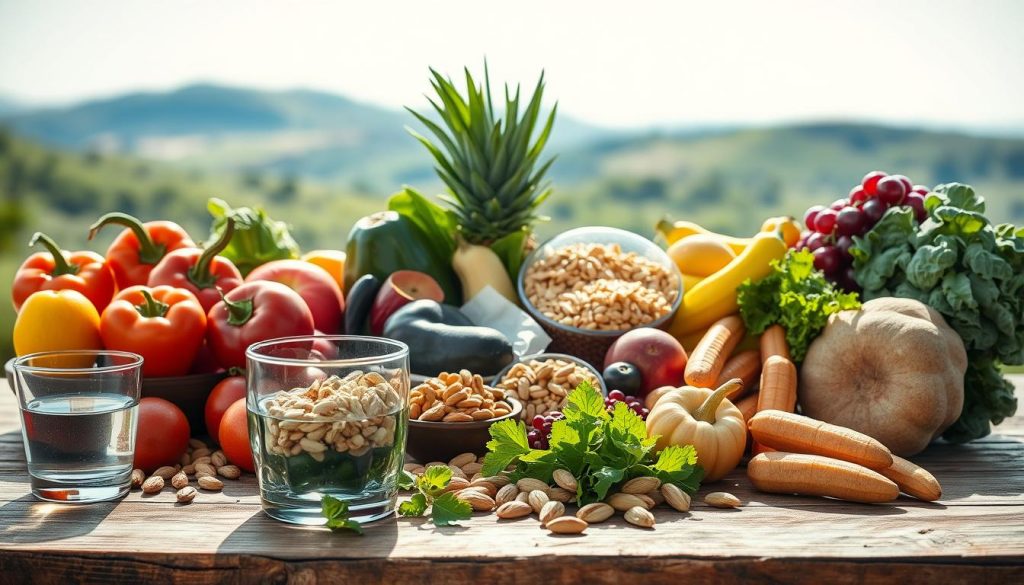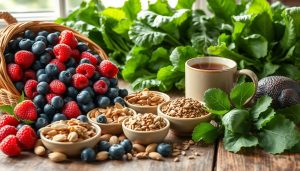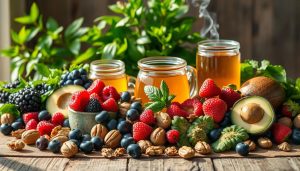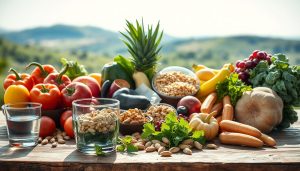Can what you eat affect your blood pressure? Yes, it can. Eating the right foods is key to keeping your heart healthy.
Eating well can lower your chance of getting high blood pressure. This is a big problem in the U.S. By choosing the right foods, you can help control your blood pressure. This can also lower your risk of other health issues.
Key Takeaways
- Eating a balanced diet is important for healthy blood pressure.
- A good diet can cut down the risk of heart disease.
- Choosing the right foods is essential for managing blood pressure.
- A healthy diet can help prevent high blood pressure.
- Adding foods rich in nutrients to your diet can boost heart health.
Understanding Blood Pressure and Its Impact on Health
Knowing about blood pressure and its health effects is key to making good lifestyle choices. Blood pressure shows how well our heart and blood vessels are working. It’s a vital sign.
What Blood Pressure Measurements Mean
Blood pressure is measured in millimeters of mercury (mmHg). It’s shown as two numbers: systolic (top number) and diastolic (bottom number). A reading of 120/80 mmHg is usually normal. Knowing these numbers is important for blood pressure management.
The Health Risks of Hypertension
Hypertension, or high blood pressure, is a big risk for heart disease, stroke, and kidney disease. It can cause serious health problems if not controlled. “Hypertension is a major cause of cardiovascular disease worldwide,” health experts say. “Managing it is key to reducing heart attack and stroke risks.”
The Role of Diet in Blood Pressure Regulation
Diet is very important for keeping blood pressure in check. Eating lots of fruits, vegetables, whole grains, and lean proteins can help. The link between diet and blood pressure is clear. Some nutrients directly affect blood pressure.
By choosing the right foods, people can actively manage their blood pressure. This can help lower the risk of related health problems.
Maintaining Healthy Blood Pressure Through Diet: The Science
Diet plays a big role in managing blood pressure. Certain nutrients can greatly affect how well we control our blood pressure. Understanding these effects is key to keeping our blood pressure healthy.
How Food Affects Blood Pressure Mechanisms
Food impacts blood pressure in several ways. It can change how blood vessels work, affect fluid balance, and influence heart rate and blood vessel tone. Nutrients like potassium, calcium, and magnesium are very important in these processes.
Short-term vs. Long-term Dietary Effects
Some foods can raise blood pressure quickly, like caffeine. But, long-term eating habits are more important for managing blood pressure. Eating a balanced diet with lots of fruits, vegetables, and whole grains helps keep blood pressure stable over time.
Key Nutrients That Regulate Blood Pressure
There are nutrients that help control blood pressure. These include:
- Potassium helps lower blood pressure by balancing sodium and relaxing blood vessels.
- Calcium is good for blood vessel health.
- Magnesium relaxes blood vessels and improves blood flow.
Research Supporting Dietary Approaches
Many studies show that diet can help manage blood pressure. The DASH and Mediterranean diets are two examples. They have been shown to lower blood pressure through diet changes.
The DASH Diet: A Proven Approach for Blood Pressure Management
The DASH diet is a well-studied way to manage blood pressure. It helps people lower their blood pressure by changing what they eat.
Principles of the DASH Diet
The DASH diet focuses on eating nutrient-rich foods. It limits sodium, added sugars, and saturated fats. It also promotes a balanced mix of food groups.
DASH Diet Food Groups and Portions
This diet suggests eating vegetables, fruits, whole grains, lean proteins, and low-fat dairy. The amounts are based on how many calories you need.
Sample DASH Meal Plan
A day on the DASH diet might start with oatmeal and fruit for breakfast. Lunch could be grilled chicken and a mixed greens salad. Dinner might be baked salmon, quinoa, and steamed broccoli. Snacks could be nuts and seeds or carrot sticks with hummus.
Research Supporting DASH Effectiveness
Many studies have found that the DASH diet lowers blood pressure in people with hypertension. It also helps reduce the risk of heart disease.
Adding the DASH diet to your life can help manage your blood pressure. It’s a step towards better health.
Mediterranean Diet and Blood Pressure Benefits
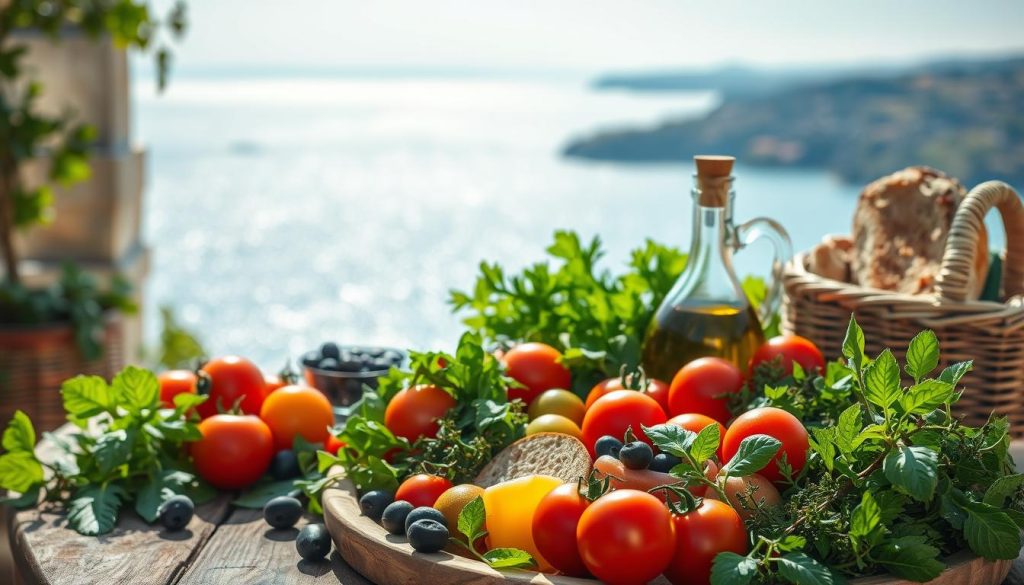
Eating like the Mediterranean can really help your heart and blood pressure. This diet is full of fruits, veggies, whole grains, and healthy fats. It’s been proven to be very good for your health.
Key Components of the Mediterranean Diet
The Mediterranean diet is packed with nutrients that are great for your heart. It includes:
- High intake of fruits and vegetables
- Whole grains as a primary source of carbohydrates
- Healthy fats, such as those found in olive oil
- Moderate consumption of fish and poultry
- Low intake of red meats and processed foods
Nutrients and their benefits:
| Nutrient | Benefit |
|---|---|
| Potassium | Helps lower blood pressure |
| Omega-3 fatty acids | Reduces inflammation |
| Fiber | Improves heart health |
How Mediterranean Eating Patterns Lower Blood Pressure
The Mediterranean diet focuses on foods that are good for your heart. A study in the Journal of the American Medical Association found it lowers the risk of heart disease, including high blood pressure.
“The Mediterranean diet is not just a diet, it’s a lifestyle. It’s about enjoying your food, being with family and friends, and having a good time.”
– Dr. Walter Willett, Harvard School of Public Health
Adapting Mediterranean Principles to American Eating
To make your diet more Mediterranean, start with small changes:
- Replace butter with olive oil
- Increase your intake of fruits and vegetables
- Choose whole grains over refined grains
Essential Nutrients for Blood Pressure Control
Some nutrients are key for keeping blood pressure healthy. Knowing their roles helps us make better food choices. Eating foods rich in these nutrients can help control blood pressure and lower the risk of heart problems.
Sodium and Potassium Balance
The right balance between sodium and potassium is important for blood pressure. Too much sodium can raise blood pressure, but potassium can help lower it. Potassium relaxes blood vessels and balances sodium’s effects.
Recommended Daily Intake Levels
The American Heart Association suggests not more than 2,300 milligrams of sodium daily. For most adults, aim for 1,500 milligrams. Potassium intake should be about 4,700 milligrams every day.
| Nutrient | Recommended Daily Intake |
|---|---|
| Sodium | 2,300 mg (max), 1,500 mg (ideal) |
| Potassium | 4,700 mg |
Calcium and Magnesium
Calcium and magnesium are also vital for blood pressure. Calcium helps control blood vessel movement. Magnesium keeps blood vessels healthy and supports blood pressure.
Eating foods high in calcium, like dairy and leafy greens, and magnesium, such as nuts and whole grains, is good.
Antioxidants and Flavonoids
Antioxidants and flavonoids in fruits, vegetables, and plants fight oxidative stress and inflammation. These can affect blood pressure.
Berries, citrus fruits, and leafy greens are full of these helpful compounds.
Power Foods That Naturally Lower Blood Pressure
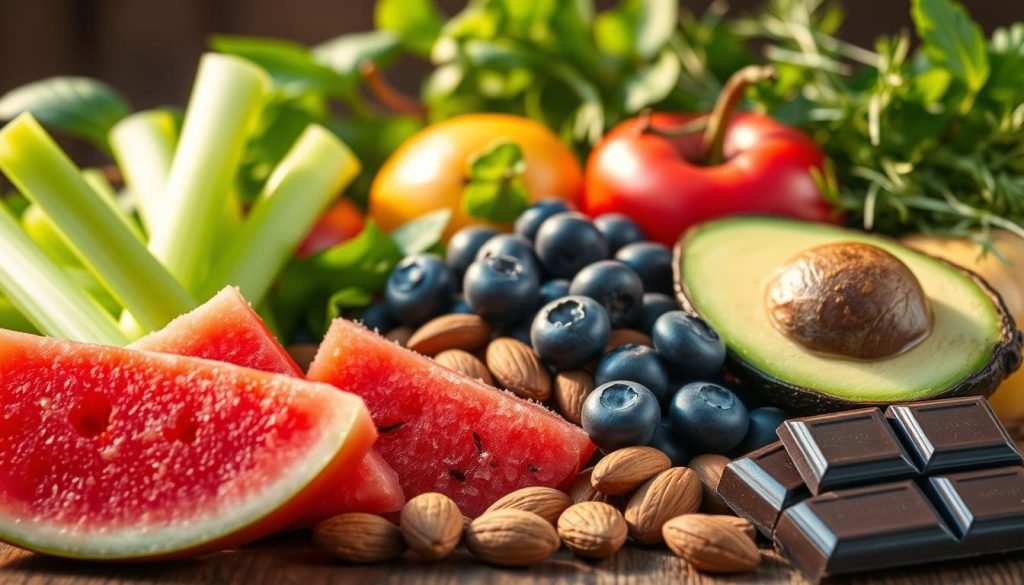
Nature gives us foods that can lower high blood pressure. Adding these to your diet is a simple way to manage hypertension.
Fruits and Vegetables for Hypertension Management
Fruits and vegetables are full of potassium, vitamins, and minerals. They help lower blood pressure. Leafy greens like spinach and kale are great because of their potassium. Berries, like blueberries and strawberries, are good for their antioxidants.
Whole Grains and Legumes
Whole grains, like brown rice and quinoa, are full of fiber. This can help lower blood pressure. Legumes, including beans and lentils, are also good. They have fiber, protein, and potassium, making them great for managing hypertension.
Heart-Healthy Fats and Proteins
Adding heart-healthy fats and proteins to your diet can help lower blood pressure. Nuts and seeds are good for healthy fats. Fatty fish, like salmon, are rich in omega-3 fatty acids.
Omega-3 Rich Foods and Their Benefits
Omega-3 fatty acids in salmon, mackerel, and sardines reduce inflammation and improve heart health. Eating these foods can help manage hypertension. Health experts say, “Omega-3s are key for heart health by lowering triglycerides and blood pressure.”
By adding these power foods to your diet, you can naturally manage your blood pressure.
Foods and Ingredients to Limit or Avoid
Managing blood pressure means eating the right foods and avoiding others. Some ingredients can raise your blood pressure.
It’s important to know where sodium hides. Sodium can increase blood pressure, not just from salt added to food.
Hidden Sources of Sodium
Many processed foods have a lot of sodium. Canned goods, frozen meals, and condiments are big offenders.
| Food Item | Sodium Content (mg) |
|---|---|
| Canned Soup | 900 |
| Frozen Meal | 700 |
| Condiments (1 tbsp) | 200 |
Processed Foods Impact on Blood Pressure
Processed foods have sodium, unhealthy fats, and sugars. These can harm your blood pressure.
Alcohol and Caffeine Considerations
Alcohol and caffeine can affect blood pressure. Drinking too much alcohol can raise blood pressure. Caffeine’s effect varies by person, and it can increase blood pressure for some.
Knowing these dietary factors helps manage blood pressure better.
Meal Planning Strategies for Blood Pressure Management
To manage blood pressure, it’s key to plan meals with blood pressure-friendly foods. A good meal plan balances your diet, cuts down on sodium, and boosts nutrient intake.
Creating Balanced Blood Pressure-Friendly Meals
For balanced meals, pick foods from various groups. Include:
- Fruits and Vegetables: Choose different colors for a variety of nutrients.
- Whole Grains: Opt for brown rice, quinoa, and whole-wheat bread.
- Lean Proteins: Go for poultry, fish, and legumes.
- Low-Fat Dairy: Add low-fat dairy for heart health.
Smart Grocery Shopping Tips
Smart shopping is vital for a healthy diet. Here’s how:
- Make a list to avoid impulse buys.
- Shop the store’s edges for fresh items.
- Check labels for low sodium and sugar.
Reading Food Labels for Blood Pressure Health
Focus on these when reading labels:
- Sodium Content: Pick items with under 200mg per serving.
- Added Sugars: Limit to 10% of daily calories.
- Nutrient Content: Choose foods high in potassium, calcium, and fiber.
Meal Prep Ideas for Busy Lifestyles
Meal prep saves time and keeps you on track. Try:
- Preparing meals for the week ahead.
- Using a slow cooker for simple meals.
- Portioning snacks and meals for easy access.
With these strategies, you can manage blood pressure and boost your health.
Lifestyle Factors That Complement Dietary Approaches
Other lifestyle changes can also help with blood pressure. A complete health plan can improve blood pressure and overall health.
Physical Activity and Blood Pressure
Regular exercise is key for managing high blood pressure. Activities like walking, cycling, or swimming for 30 minutes daily can lower blood pressure. Exercise also makes dietary changes more effective in reducing blood pressure.
Stress Management Techniques
Stress can raise blood pressure. Techniques like meditation, deep breathing, or yoga can help. Managing stress is vital for controlling blood pressure, alongside diet.
Sleep Quality and Hypertension
Poor sleep can lead to higher blood pressure. Getting enough sleep and keeping a regular sleep schedule is important. Good sleep habits support diet and lifestyle efforts to manage blood pressure.
Combining a healthy diet with exercise, stress management, and good sleep can create a strong plan for managing blood pressure. This approach can also improve overall health.
Special Dietary Considerations for Different Populations
Managing blood pressure isn’t a one-size-fits-all job. Different groups need their own dietary plans. It’s key to know what each group needs to control blood pressure well.
Older Adults and Blood Pressure Management
Older adults find it hard to manage blood pressure. This is due to less activity, diet changes, and health issues with age. A diet full of potassium, calcium, and fiber helps a lot. Foods like bananas, leafy greens, and whole grains are great for blood pressure.
Dietary Approaches for Different Ethnic Groups
Traditional diets vary among ethnic groups, affecting blood pressure. The DASH diet, for example, has been made to fit many cultures. Adding foods from traditional diets that are full of fruits, veggies, and whole grains is good.
Managing Blood Pressure with Coexisting Conditions
People with other health issues, like diabetes or kidney disease, need special diets for blood pressure. For kidney disease, eating less protein is important. A diet that balances these needs is essential.
| Population Group | Dietary Recommendations | Key Foods |
|---|---|---|
| Older Adults | Rich in potassium, calcium, and fiber | Bananas, leafy greens, whole grains |
| Different Ethnic Groups | Adapted DASH diet, culturally relevant foods | Fruits, vegetables, whole grains |
| Coexisting Conditions | Balanced diet, condition-specific limitations | Varies based on condition |
Conclusion: Creating Your Sustainable Blood Pressure Management Plan
By using the dietary tips and lifestyle changes we’ve talked about, you can lower your blood pressure. Eat more fruits, veggies, whole grains, and lean proteins. Try to eat less sodium and avoid processed foods.
A good blood pressure plan is about making lasting changes. Stick to the DASH diet or Mediterranean eating to control your blood pressure. This can help prevent serious health issues.
Take charge of your blood pressure with the right knowledge and tools. Begin with small changes in your daily life. Aim for a healthier lifestyle step by step. With hard work and commitment, you can become a healthier version of yourself.

